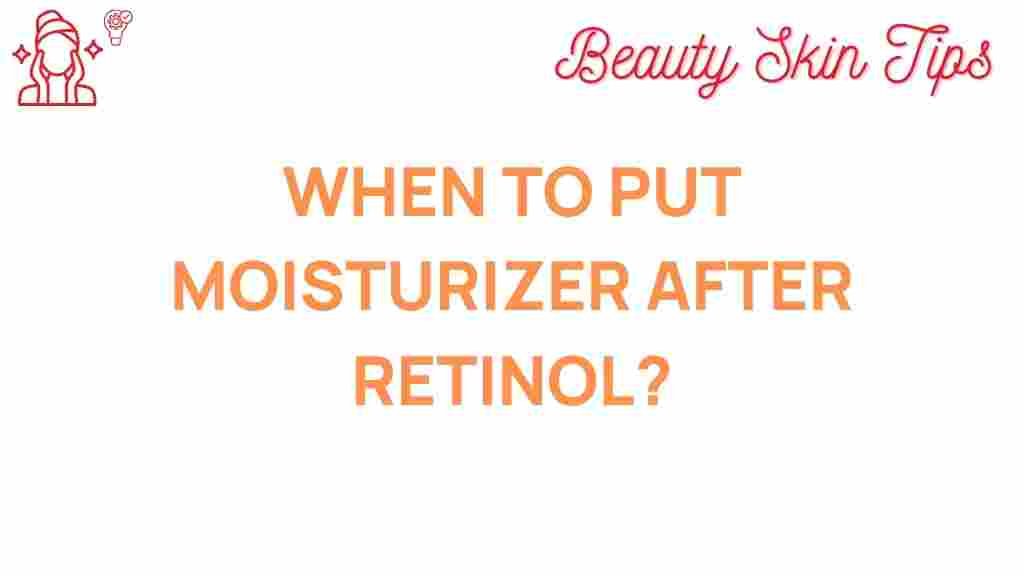The Perfect Timing: When to Apply Moisturizer After Retinol
Retinol has become a buzzword in the skincare industry, known for its incredible ability to improve skin texture, reduce fine lines, and combat acne. However, with great power comes great responsibility, especially when it comes to the order of your skincare routine. One of the most common questions individuals have is, “When should I apply moisturizer after retinol?” In this article, we’ll explore the perfect timing for applying moisturizer after retinol, ensuring you maximize the benefits while minimizing potential irritation.
Understanding Retinol
Before diving into the specifics of moisturizer application, it’s essential to understand what retinol is and how it works. Retinol is a derivative of vitamin A that promotes cell turnover and encourages the production of new skin cells. This powerful ingredient can:
- Reduce the appearance of fine lines and wrinkles
- Help fade dark spots and hyperpigmentation
- Unclog pores and reduce acne breakouts
Despite its benefits, retinol can cause dryness and irritation, particularly for those with sensitive skin. This is where the timing of your moisturizer application becomes crucial.
Step-by-Step Guide: When to Apply Moisturizer After Retinol
Applying moisturizer after retinol is an art that can vary from person to person. Here’s a step-by-step guide to help you find the perfect timing:
Step 1: Cleanse Your Skin
Start with a gentle cleanser to remove impurities and prepare your skin for retinol. Ensure that your skin is completely dry before moving on to the next step. This can help reduce the likelihood of irritation.
Step 2: Apply Retinol
Take a pea-sized amount of retinol and apply it evenly across your face, avoiding the eye area. Patience is key here; allow the retinol to absorb into your skin for about 20 to 30 minutes. This waiting period is essential as it gives the retinol enough time to penetrate effectively.
Step 3: Assess Your Skin’s Tolerance
During the waiting period, pay attention to how your skin feels. If you experience mild tingling or warmth, this is usually normal. However, if you feel burning or excessive irritation, it may be best to remove the product and consult with a dermatologist.
Step 4: Apply Moisturizer
After the waiting period, it’s time to apply your moisturizer. Choose a product that is hydrating and soothing to help counteract any dryness caused by retinol. Look for ingredients like:
- Hyaluronic acid
- Glycerin
- Aloe vera
- Ceramides
Gently massage the moisturizer into your skin in an upward motion, ensuring that it locks in hydration and helps soothe any potential irritation.
Why Timing Matters
The timing of moisturizer application after retinol is vital for several reasons:
- Minimizes Irritation: Applying moisturizer immediately after retinol can dilute the active ingredient, reducing its effectiveness. Waiting allows retinol to work optimally.
- Enhances Hydration: By applying moisturizer afterward, you can counteract the drying effects of retinol, keeping your skin hydrated and healthy.
- Boosts Efficacy: Proper timing can increase the overall benefits of retinol, helping you achieve visible results more efficiently.
Troubleshooting: Common Issues with Retinol and Moisturizer
Even with the right application timing, some may still face challenges. Here are some common issues and how to address them:
1. Excessive Dryness
If your skin feels excessively dry, consider the following:
- Switch to a more hydrating moisturizer.
- Use a moisturizer containing occlusives like petrolatum or dimethicone to lock in moisture.
- Reduce the frequency of retinol application until your skin builds tolerance.
2. Irritation or Redness
For irritation or redness, try these tips:
- Apply a soothing serum before the moisturizer, such as one containing niacinamide or chamomile.
- Consider using a lower concentration of retinol.
- Consult your dermatologist for personalized recommendations.
3. Breakouts
Sometimes, retinol can cause initial breakouts, commonly referred to as “purging.” If this occurs:
- Stick with your routine; purging usually subsides after a few weeks.
- Use a gentle exfoliating product once a week to help clear clogged pores.
- Consult a dermatologist if breakouts persist or worsen.
Tips for Maximizing Retinol Benefits
To get the most out of your retinol experience, consider the following tips:
- Start Slowly: If you’re new to retinol, begin with a lower concentration and gradually increase as your skin builds tolerance.
- Use Sunscreen: Retinol can increase sun sensitivity, so it’s essential to apply broad-spectrum sunscreen during the day.
- Be Consistent: Results take time, so stick to your routine and give your skin time to adjust.
- Hydrate Internally: Drink plenty of water to keep your skin hydrated from within.
Conclusion
Understanding when to apply moisturizer after retinol can significantly influence your skincare results. By following the outlined steps and tips, you can enhance the efficacy of retinol while keeping your skin healthy and hydrated. Remember, everyone’s skin is unique, so pay attention to how your skin reacts and adjust your routine accordingly.
For more detailed skincare advice, feel free to explore our other articles here. Always consult with a dermatologist if you’re unsure about your skincare routine, especially when incorporating potent ingredients like retinol.
For additional information on retinol and its benefits, check out this helpful resource here.
This article is in the category Skincare and created by BeautySkinTips Team
